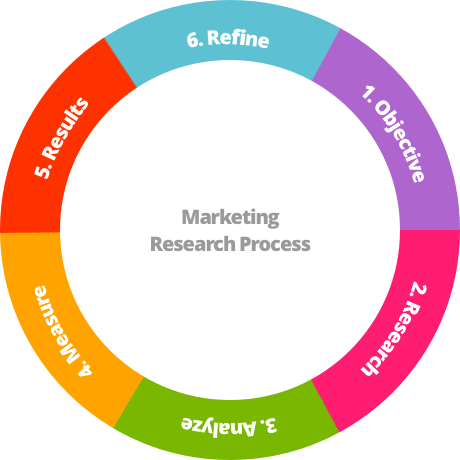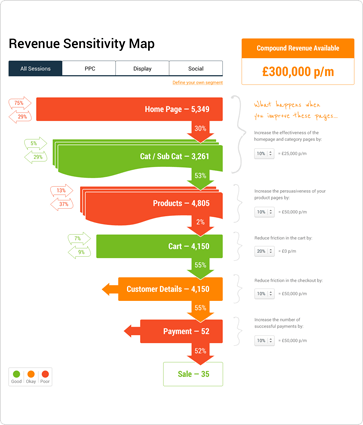The Marketing Research Process In 6 Steps
For people who want to make clear business decisions and know what to do to reach their growth targets.
Most focus their budget on acquiring more visitors like everyone else. But with higher ad costs and competition your revenue per visitor is diminishing. This is why we follow a process for figuring out the best way to grow profits.
Use this six step marketing research process to make better business decisions for growth:
- Define your objectives and problem.
- Get inside the heads of your visitors/customers with in-depth research.
- Understand what you can do to increase profits.
- Measure results with a successful testing program.
- Be confident in the impact your changes are making.
- Increase your win rate and impact with a continuously updated customer theory.
1. Define your objectives and problem
The most important part is to start with the end in mind. It gets our mind looking for the right things.
Imagine we’re sitting together in a professional sport stadium. Looking around we see that the stadium is packed.
You close your eyes and I ask “How many red shirts did you see?”. You tell me you have no idea because you weren’t specifically looking for red shirts.
Now I ask you to look around and count how many red shirts you see. You gently open your eyes and start seeing red shirts throughout the stadium.
I call this the red shirt technique and we use it throughout the marketing process.
Typical examples of some objectives might be “How do we grow the business by 30% year over year?” or “How do we get more customers?”. Once you have yours it’s time to ask a couple questions which will help lead us into our research phase.
- What’s stopping you from reaching your goal?
- What area of the business is underperforming?
Becoming a customer helps you understand the thought process in each step.
2. Get inside the heads of your visitors/customers with in-depth research
When doing market research always come with a question first. It helps you narrow down the data and tools you’ll need to answer it. After analysis you’ll often have more questions or might not have the data you need. If you don’t have the data you need then you’ll have to go and get it.
For example if I’m trying to figure out how to grow a business by over 30% I start with my funnel ROI and Profit Grid reports that help pinpoint some areas to look further into.
Some areas raise questions which further propels you into more data. Once you find a problem then you triangulate it with other data (quantitative and qualitative). Quantitative reports and tools tell you what is happening but it doesn’t tell you why it’s happening.
There’s lots of tools we can use for research but the trick is to use the ones that will help triangulate the problem and help you understand it.
Examples of market research include collecting and analyzing data from:
- Analytics
- Site walkthroughs
- Heuristic analysis
- Usability checklists
- Competitor analysis
- Customer Surveys
- Heat maps
- User tests.
3. Understand what you can do to increase profits
The 80-20 rule shows up here in that we want to know what the 20% of efforts will give us 80% of our results. We take all the insights from the research and prioritize them based on biggest impact and lowest development time. Giving us a roadmap for growth.
We also analyze the research notes to give us clues to the customer psychogram. So we know what they like, what their intentions are, what their objections are, and what persuades them.
You’ll also put together what types of core values customers have. Then compare it to what core values you’re aligned with compared to your competition.
4. Measure results with a successful testing program
We know where the problem is and we have ideas but we don’t know for sure what will work because we don’t have a crystal ball. Instead of the age old throw spagetthi at the wall and see what sticks we actually measure the impact of our changes to see if it moves us closer to our goals.
We keep score measured by number of tests run, the percent of winning tests, and the impact per successful test.
5. Be confident in the impact your changes are making
Your tests need to be analyzed for not only significance but accurate sample size and duration.
Do testing right or you end up just spinning your tires thinking you’re doing something but you haven’t left the parking lot. To see accurate results requires more than just statistical significance over 90%. You need a minimum sample size, conversions, and minimum two business cycles.
Here's a pre-test duration calculator and sample size calculator.
6. Increase your win rate and impact with a continuously updated customer theory
If you understand what made the difference, you can repeat that in next tests and dramatically increase your chances of increasing profits next time around.
The one who knows their customer the best wins.
Get your FREE website strategy session
If your business generates over $1m online, one of our experts will discuss your conversion goals and suggest strategies to double your sales.





